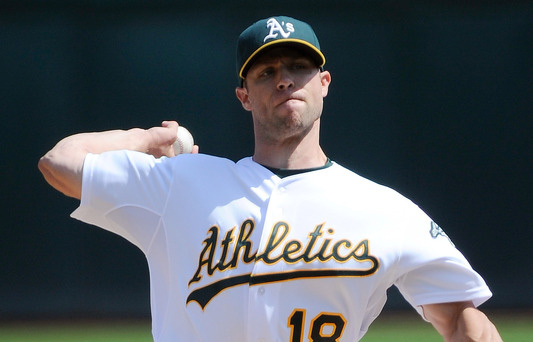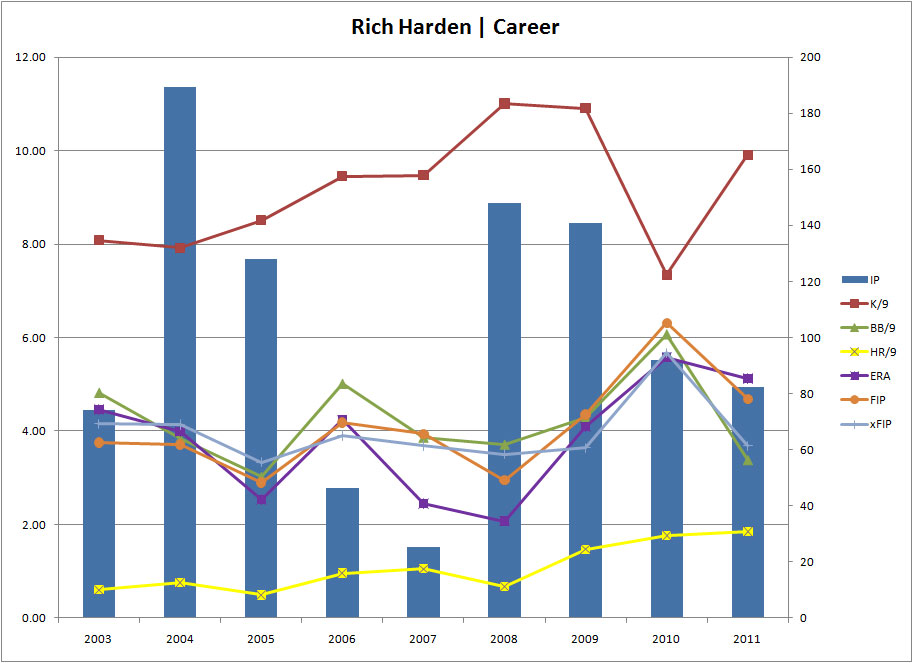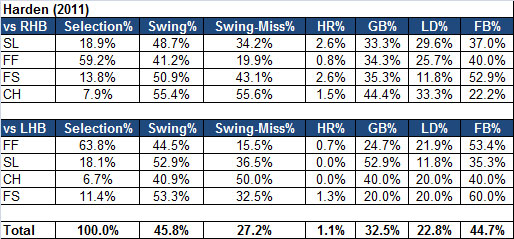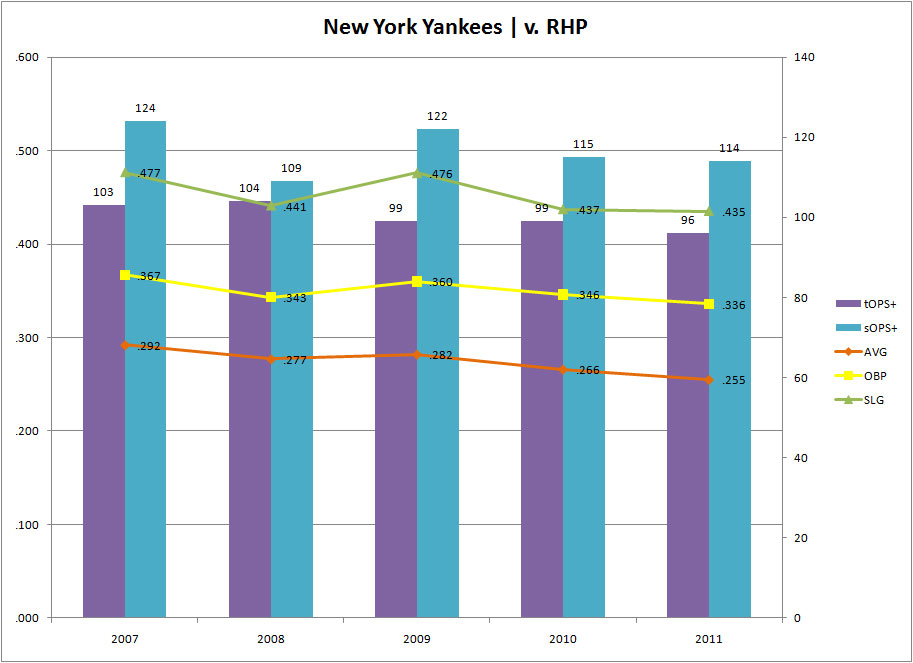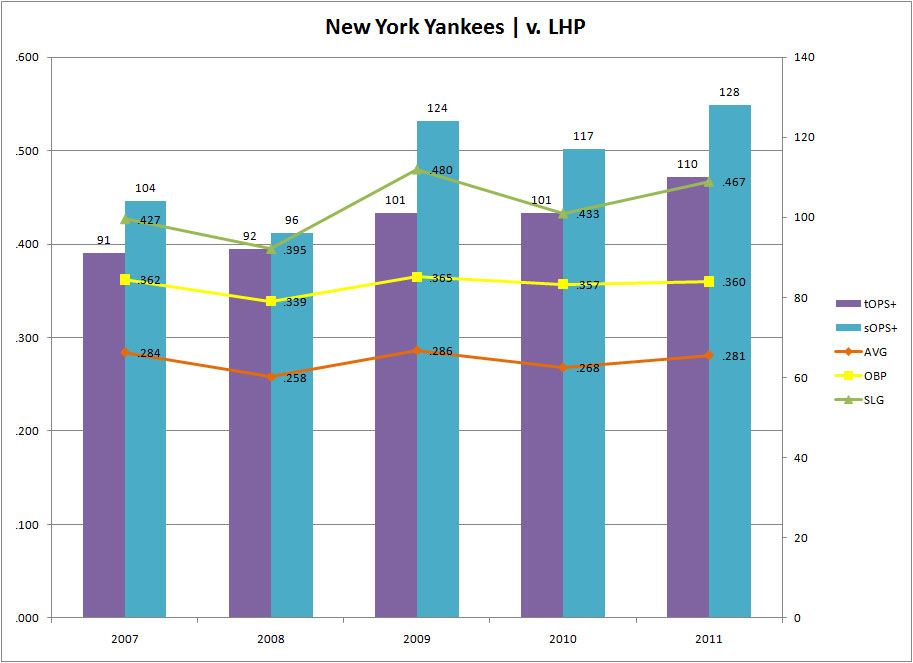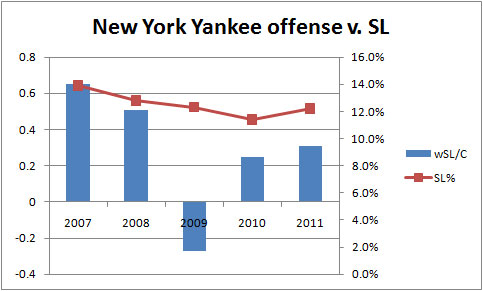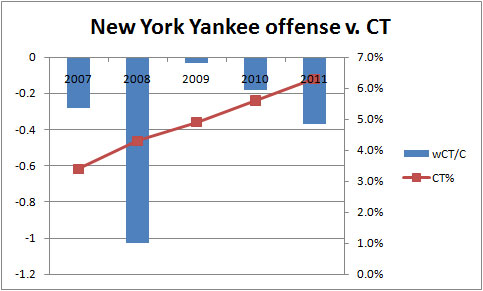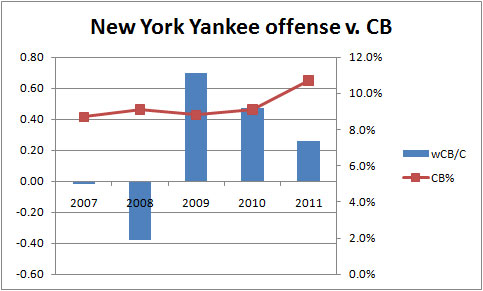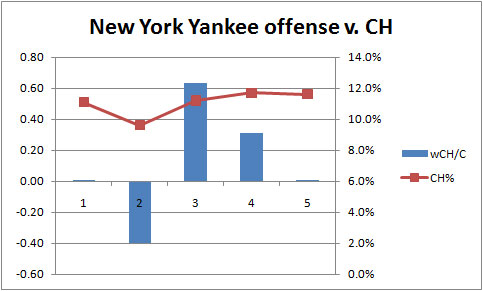Ah, RISP Fail, a phenomenon that really gained traction — merited or not — during the 2010 season. Last year’s team posted a .267/.357/.441 line with runners on, good for a 103 tOPS+, and 12% better than league average (112 sOPS+); and a .258/.363/.420 line with runners in scoring position, which was essentially exactly how they hit in all other situations (100 tOPS+), and a mark 9% better than league average.
While those full-season numbers with runners on and RISP are plenty respectable, the RISP Fail meme grew to apocalyptic proportions during the 2010 season’s final month, as the team hit just .225/.350/.331 (.681 OPS) in 338 September plate appearances with runners in scoring position. Coupled with an anemic offensive performance against Texas in the 2010 ALCS, and the team’s seeming futility with runners in scoring position became an easy scapegoat for the team’s shortcomings.
So was there any truth to this perception? Below are two charts showing the team’s numbers with runners on and with runners in scoring position going back to 2007. As an aside, the reason I’ve chosen 2007 as the cutoff for the majority of the historical team-wide comparisons I’ve been doing thus far is because several seasons worth of data helps detect patterns and/or trends, but going back any further than five years will likely make any conclusions less meaningful given that the composition of both the team and the league was quite a bit different. Even going back to 2007 doesn’t really tell you anything about the 2011 team, but simply showing the 2010 and 2011 numbers paints a fairly limited picture.
Anyway. (click to enlarge)
It turns out the one year fans may have actually had a legitimate gripe regarding the team plating baserunners was 2008, the only season of these five they were below-league average both with runners on and runners in scoring position. Though the 2010 season did end up coming in as the second-lowest of the five in terms of sOPS+, lending perhaps some credence to the frustration with the team’s periodic inability to hit with RISP, at least in comparison to how Yankee teams of recent vintage fared.
Fortunately the 2011 team put the 2010 Yankees to shame when it came to hitting with both men on and runners in scoring position, posting five-year highs in both tOPS+ and sOPS+ in both splits. In fact, they were the second-best hitting team with runners on and the best-hitting team with runners in scoring position compared to the league in 2011:
| Men on | AVG | OBP | SLG | tOPS+ | sOPS+ |
| BOS | .294 | .364 | .474 | 107 | 127 |
| NYY | .270 | .349 | .465 | 106 | 120 |
| DET | .288 | .349 | .444 | 105 | 115 |
| TEX | .277 | .335 | .438 | 94 | 110 |
| BAL | .266 | .329 | .432 | 109 | 106 |
| CLE | .271 | .345 | .412 | 113 | 106 |
| KCR | .277 | .330 | .419 | 101 | 103 |
| CHW | .259 | .333 | .401 | 108 | 100 |
| TBR | .242 | .326 | .406 | 102 | 99 |
| TOR | .248 | .324 | .406 | 100 | 98 |
| LAA | .252 | .316 | .406 | 102 | 96 |
| OAK | .254 | .321 | .376 | 105 | 90 |
| MIN | .253 | .317 | .360 | 104 | 85 |
| SEA | .241 | .307 | .357 | 108 | 81 |
| RISP | AVG | OBP | SLG | tOPS+ | sOPS+ |
| NYY | .273 | .361 | .455 | 108 | 122 |
| BOS | .278 | .359 | .452 | 101 | 121 |
| TEX | .285 | .354 | .450 | 102 | 119 |
| DET | .280 | .350 | .426 | 101 | 112 |
| CLE | .269 | .354 | .409 | 115 | 108 |
| KCR | .276 | .333 | .426 | 104 | 107 |
| BAL | .263 | .332 | .416 | 106 | 104 |
| OAK | .266 | .340 | .399 | 118 | 102 |
| LAA | .255 | .334 | .405 | 108 | 102 |
| TOR | .237 | .331 | .387 | 98 | 96 |
| CHW | .239 | .324 | .373 | 98 | 90 |
| TBR | .224 | .322 | .371 | 92 | 89 |
| MIN | .248 | .319 | .354 | 103 | 84 |
| SEA | .222 | .306 | .325 | 98 | 73 |
Interestingly, Cleveland of all teams really turned things on when they had runners on, compared to the way they hit in all situations, with an AL-high 113 tOPS+ with men on, and a second-best-in-the-league 115 tOPS+ with runners in scoring position. Strangely enough, Oakland led the league in tOPS+ with RISP, hitting 18% better than usual in these situations, though given their overall season line of .244/.311/.369 that’s still not saying much.
Also, next time you’re concerned about the Yankees’ hitting with RISP, just be glad you’re not a Mariners fan. The folks in Seattle must be among the most patient in the world; I’m not sure how you follow a baseball team that not only put up a .233/.292/.348 line over 162 games, but actually managed to hit 2% worse than that with runners in scoring position.


